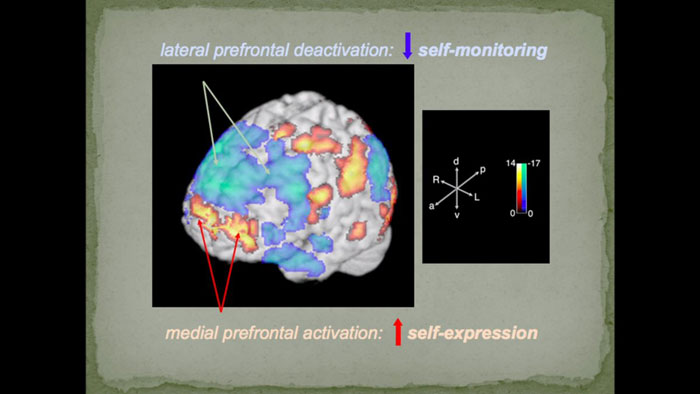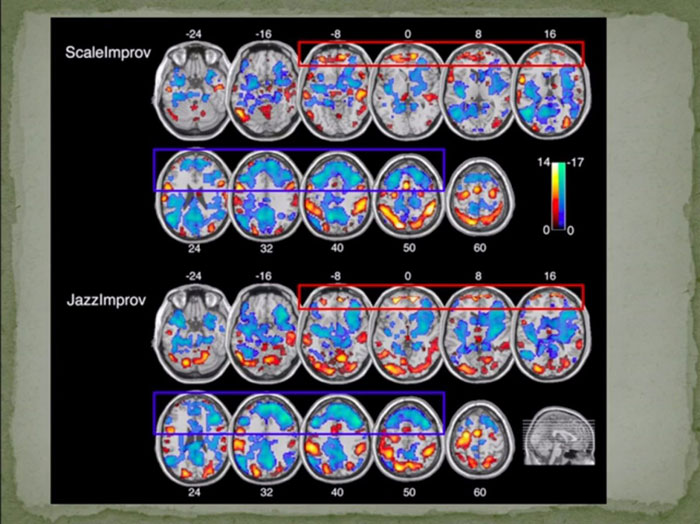The best musicians are somehow able to come up with a song or piece of music on the fly that no one has ever heard before. They just let the music flow, riffing off something that exists and creating something new.
That's what we call creative genius. But where does this improvisational ability come from? Charles Limb, a music-obsessed otolaryngologist and surgeon, wanted to know exactly that.
Over the past few years, he's put jazz musicans and rappers into MRI machines to see what's happening in their brain as they freestyle and improvise.
Results showed that when someone is creating something new, parts of the brain associated with self-expression (language and at times, especially while freestyle rapping, parts associated with visual imagery) are highly active.
At the same time, and perhaps more interestingly, another part of the brain associated with inhibition quiets down. At a TEDx talk in 2010, he said it looks like it does this "so that you're not inhibited, so that you're willing to make mistakes, so that you're not constantly shutting down all of these new generative impulses".
Below is a graphic from Limb's studies that shows that while improvising, areas of the brain involved in self-monitoring – the sort of thing that might stop creativity – quiet down (those are blue); while areas of the brain connected to expression and language become very active (in red).
 TED
TED
It's important to be cautious about research like this, as Limb notes, because we're just scratching the surface here. We know very little about how the brain works. Plus, images of what's happening in the brain – as fascinating as they are – are still a sort of observational science. We see something that's happening but don't know what's driving it and certainly can't manipulate it yet, flipping a creative switch.
But this is a start to understanding what creativity looks like.
To first look at what was happening as a jazz musician came up with something new, Limb had six musicians go through a set of steps. First he had them play scales, then improvise on them. Then they played a memoriSed piece of music, and finally an improvised version of that – all while inside an MRI scanner.
But they were up to the challenge. And all showed similar results while improvising – a dampening of parts of the brain associated with inhibition and an increase in activity associated with self expression.
Here's another graphic showing the way that brain activity changed. Blue is a decrease in activity, red is an increase:
 TED
TED
When Limb first published his research on the topic, co-author Allen Braun noted the similarities between the brains of improvisers and the brains of people in REM sleep – while they were dreaming.
"It's tantalising to think some connection exists between improvisation and dreaming, which are both spontaneous events. These musicians may in fact be in a waking dream," Braun told Hopkins Medicine.
Limb has followed this up with other research since then. He's shown that while improvising with partners, musicians' language centres in the brain are highly active, lending support to the idea that their music may actually be understood by the brain as a 'language' on its own.
More than anything else, it's fascinating to start to look at what creativity is on a neurological level. After all, the brain is perhaps the greatest unexplored frontier in understanding how people work.
We've mapped the human genome but are still trying to understand the massive network of neurons and glial cells beneath our skull. Concepts like creativity – the ability to make a mental leap and come up with something new – are even more mysterious.
"We know very little about how we are able to be creative," Limb says in the TED talk. But as he told Hopkins Medicine before, creativity is a fundamental part of humanity.
"Without this type of creativity, humans wouldn't have advanced as a species," says Limb. "It's an integral part of who we are."
Check out the full TEDx talk:

This article was originally published by Business Insider.
More from Business Insider:
